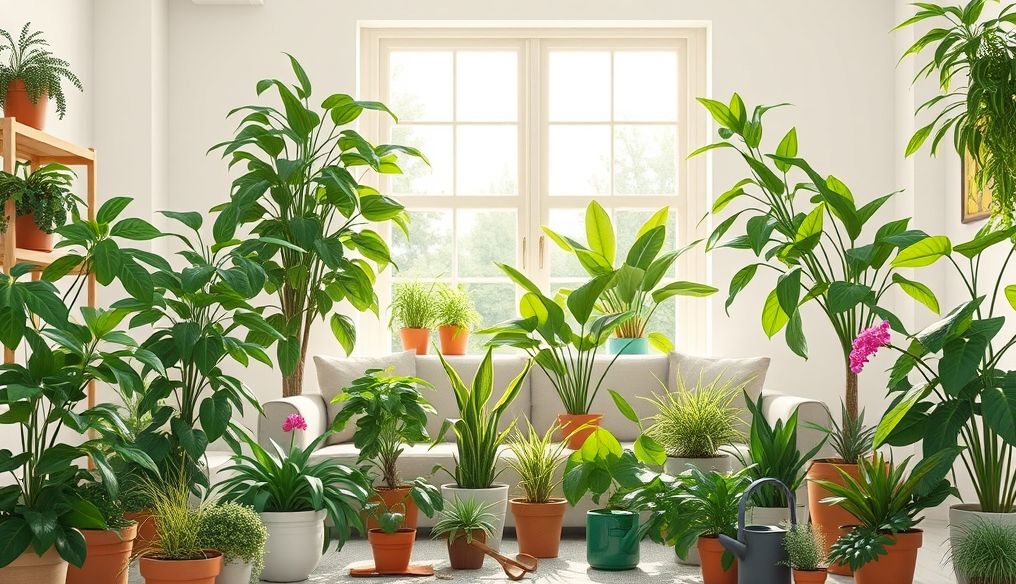Introduction: The Enchanting World of Houseplants
Houseplants are not just decorative elements; they are living beings that add beauty and tranquility to our homes. In addition, they purify the air and improve its quality, making them a valuable addition to our health and well-being. But how do we ensure their healthy growth and flourishing? This is what we will discuss in detail in this article.
Chapter 1: Understanding Your Plants' Needs
Every plant has its own specific needs, just like us. Understanding these needs is the first step towards successful care. These needs include:
- Light: The amount of light the plant needs.
- Water: The frequency and amount of watering.
- Soil: The appropriate type of soil.
- Humidity: The level of surrounding humidity.
- Temperature: The ideal temperature range.
Tip: Search for the specific name of your plant and read about its particular needs. Many resources are available online and in libraries.
Chapter 2: Light: The Key to Growth
Light is the primary source of energy for plants. Without it, they cannot perform photosynthesis and produce food. There are three main types of light:
- Direct Light: Reaches the plant directly from the sun.
- Indirect Light: Passes through a window or curtain.
- Artificial Light: Comes from grow lights.
Most houseplants prefer bright, indirect light. Avoid exposing plants to direct sunlight for extended periods, especially during the summer, as this can lead to leaf burn.
Example: Plants like Dracaena and Sansevieria tolerate shade, while flowering plants like Bougainvillea need plenty of light.
Chapter 3: Water: The Art of Correct Watering
Watering is one of the most important aspects of plant care. Overwatering or underwatering can be fatal. Here are some tips:
- Check Soil Moisture: Before watering, insert your finger into the soil. If it's dry, it's time to water.
- Use Lukewarm Water: Water that is too cold or too hot can shock the plant.
- Water from Below: Place the plant in a bowl filled with water and let it absorb the water through the drainage holes.
- Avoid Overwatering: Allow the soil to dry out slightly between waterings.
Warning: Overwatering leads to root rot, a common problem that affects houseplants.
Chapter 4: Soil: The Foundation of Growth
Soil provides physical support and the necessary nutrients for plants. There are different types of soil, each with its own characteristics:
- Clay Soil: Retains a lot of water but can be too heavy.
- Sandy Soil: Dries quickly but does not retain nutrients well.
- Loamy Soil: An ideal mix of clay, sand, and silt.
- Potting Mix: A mixture specifically designed for potted plants.
Choose the right soil for your plant type. Most houseplants prefer a well-draining potting mix.
Chapter 5: Humidity: A Comfortable Environment
Humidity is the amount of water vapor in the air. Many houseplants, especially tropical plants, prefer high humidity. Here are some ways to increase humidity:
- Mist the Leaves: Spray the leaves with water regularly.
- Use a Humidifier: A humidifier can increase the humidity in the entire room.
- Group Plants Together: Plants release moisture through transpiration, so grouping them together creates a more humid environment.
- Humidity Tray: Place the plant on a tray filled with pebbles and water. Make sure the bottom of the pot does not touch the water directly.
Chapter 6: Fertilizing: Nourishing Your Plants
Fertilizing is the process of adding nutrients to the soil. Plants need nutrients for healthy growth and flourishing. There are two main types of fertilizers:
- Organic Fertilizers: Made from natural materials such as compost and animal manure.
- Chemical Fertilizers: Made from manufactured chemicals.
Follow the manufacturer's instructions when using fertilizers. Over-fertilizing can burn the roots and harm the plant.
Tip: Fertilize your plants during the growing season (spring and summer) and reduce or stop fertilizing during the winter.
Chapter 7: Pests and Diseases: Protection and Treatment
Houseplants are susceptible to pests and diseases. Here are some common pests and how to deal with them:
- Aphids: Small insects that suck plant sap. They can be removed with water and soap or using a natural insecticide.
- Mealybugs: Small white insects covered in a waxy substance. They can be removed with alcohol or using an insecticide.
- Spider Mites: Small pests that cause yellow spots on the leaves. They can be controlled by increasing humidity or using an insecticide.
Tip: Inspect your plants regularly for signs of pests and diseases. The earlier you detect the problem, the easier it is to treat.
Chapter 8: Pruning: Maintaining Shape and Health
Pruning is the process of removing dead, damaged, or overgrown parts of the plant. Pruning helps maintain the plant's shape and encourages new growth. Here are some tips:
- Use Sharp and Clean Scissors: To prevent the spread of diseases.
- Remove Dead or Damaged Leaves and Branches: These parts drain the plant's energy.
- Prune Plants Regularly: To maintain their shape and encourage new growth.
Chapter 9: Repotting: Providing Space for Growth
As the plant grows, it may need a larger pot. Here's how to repot:
- Choose a pot slightly larger than the current pot.
- Fill the new pot with potting mix.
- Carefully remove the plant from the old pot.
- Place the plant in the new pot and fill the gaps with soil.
- Water the plant well.
Tip: Repot every year or two, or when you see roots growing out of the drainage holes.
Chapter 10: Enjoying the Beauty of Your Plants
Caring for houseplants is an enjoyable and rewarding journey. Enjoy the beauty of your plants and watch them grow and flourish. Remember that each plant is unique, and it may take some time to learn its specific needs. Be patient and persistent, and you will be rewarded with a home full of greenery and life.
Important Note: This article provides general information about houseplant care. For specific information about your plant type, please consult reliable sources or a horticulture specialist.




